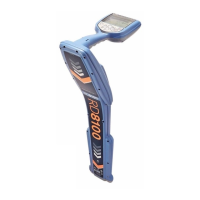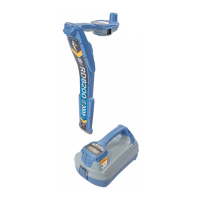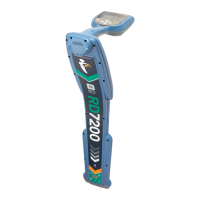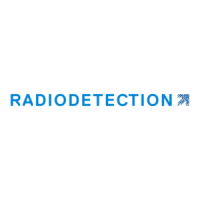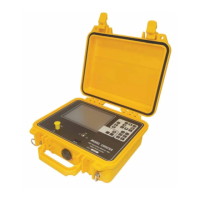RD8000 Operation Manual 9
3.6.3 Selecting frequencies
It is important to select the correct or appropriate
frequency for your particular application. For more
information see Section 6 or refer to the ABC & XYZ of
locating buried pipes and cables, which is available as a
free download from www.radiodetection.com
To select a frequency on the receiver:
Switch the unit on by pressing the key,
if you have not already done so.
Press the key to cycle through available
frequencies.
Alternatively, hold down the key and press the
up or down arrows to cycle up or down the range
of frequencies.
If using an active frequency you must also set your
transmitter to output the matching frequency. You can
change your transmitter’s output frequency manually
using your transmitter’s keypad or automatically using
iLOC (iLOC enabled receivers and transmitters only).
To manually select a transmitter output
frequency:
Switch the unit on by pressing the
key, if you have not already done so.
Press the key to cycle through available
frequencies.
To change frequencies using iLOC, please refer to Section
6.
NOTE: Some frequencies require that you connect
an accessory, for example an A-Frame, before the
frequency is available.
3.7 TruDepth™ measurement
The RD8000 uses TruDepth to automatically estimate
depth when a good reading is established.
NOTE: TruDepth only indicates a locate depth when
the receiver is correctly oriented directly above the
detected pipe or cable.
To help you orient the receiver correctly, you can use the
receiver’s compass on the LCD.
Depth readings are displayed according to your preferred
units of measurement as follows:
Less than 1 meter: depth is displayed in centimeters
Greater than 1 meter: depth is displayed in meters.
Less than 3 feet: depth is displayed in inches.
Greater than 3 feet: depth is displayed in feet.
For more information on measuring depth, please refer to
Section 8.
1.
2.
3.
1.
2.
•
•
•
•
3.8 SideStepauto™
SideStepauto allows the transmitter to calculate the
optimum frequency based on ground impedance.
The transmitter uses this information to optimize the
active frequency. SideStepauto helps to improve locate
accuracy by determining the best signal. SideStepauto
can also help to prolong battery life.
NOTE: SideStepauto will only work in direct connection
mode. Inductive frequencies are not supported.
3.8.1 Using SideStepauto
To enable SideStepauto
Switch on the transmitter.
Press the key to enter the menu.
Scroll to the OPT F option using the
or
arrows.
Press the key to enter the OPT F menu.
Scroll to the START option using the
or
arrows.
Press the key to start SideStepauto and exit
the OPT F menu.
Press the key to exit the menu.
To disable SideStepauto
Switch on the transmitter.
Press the key to enter the menu.
Scroll to the OPT F option using the
or
arrows.
Press the key to enter the OPT F menu.
Scroll to the EXIT option using the
or
arrows.
Press the key to disable SideStepauto and exit
the OPT F menu.
Press the key to exit the menu.
3.9 Dynamic overload protection
Dynamic overload protection (DOP) allows you to locate
accurately in areas with high levels of electromagnetic
interference, such as sub-stations and beneath high-
voltage transmission lines. DOP works by disregarding
signal spikes that would otherwise overwhelm the
RD8000’s digital signal processor. DOP is an integrated
feature of the RD8000. No action is required by the user.
1.
2.
3.
4.
5.
6.
7.
1.
2.
3.
4.
5.
6.
7.

